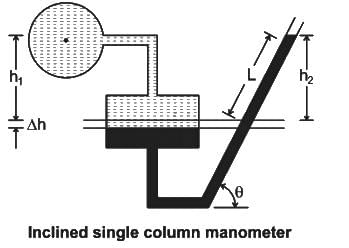Civil Engineering (CE) Exam > Civil Engineering (CE) Questions > Sensitivity of U-tube manometer with inclined...
Start Learning for Free
Sensitivity of U-tube manometer with inclined leg depends on:
- a)specific weight of fluid
- b)length of inclined leg
- c)angle of inclination of leg
- d)atmospheric pressure
Correct answer is option 'C'. Can you explain this answer?
Most Upvoted Answer
Sensitivity of U-tube manometer with inclined leg depends on:a)specifi...
The sensitivity of a U-tube manometer with an inclined leg depends on the angle of inclination of the leg. Here is an explanation of why this is the case:
- The U-tube manometer is a device used to measure the pressure difference between two points in a fluid. It consists of a U-shaped tube filled with a liquid, with one leg being vertical and the other leg being inclined at an angle.
- The sensitivity of the manometer refers to the change in the liquid column height for a given change in pressure difference. It is a measure of how responsive the manometer is to small changes in pressure.
- The sensitivity of the manometer depends on the angle of inclination of the leg. When the leg is inclined, the vertical component of the liquid column height is reduced, while the horizontal component is increased.
- The change in the vertical component of the liquid column height is directly proportional to the pressure difference being measured. Therefore, a smaller vertical component will result in a smaller change in the liquid column height for a given pressure difference.
- On the other hand, the change in the horizontal component of the liquid column height is inversely proportional to the angle of inclination. A larger angle of inclination will result in a smaller change in the horizontal component for a given change in pressure.
- The total change in the liquid column height is the vector sum of the vertical and horizontal components. As the angle of inclination increases, the vertical component decreases while the horizontal component increases, resulting in a smaller total change in the liquid column height for a given pressure difference.
- Therefore, the sensitivity of the manometer decreases with an increase in the angle of inclination of the leg. A smaller angle of inclination will result in a larger change in the liquid column height for a given pressure difference, making the manometer more sensitive.
In conclusion, the sensitivity of a U-tube manometer with an inclined leg depends on the angle of inclination of the leg. A smaller angle of inclination will result in a higher sensitivity, while a larger angle of inclination will result in a lower sensitivity.
- The U-tube manometer is a device used to measure the pressure difference between two points in a fluid. It consists of a U-shaped tube filled with a liquid, with one leg being vertical and the other leg being inclined at an angle.
- The sensitivity of the manometer refers to the change in the liquid column height for a given change in pressure difference. It is a measure of how responsive the manometer is to small changes in pressure.
- The sensitivity of the manometer depends on the angle of inclination of the leg. When the leg is inclined, the vertical component of the liquid column height is reduced, while the horizontal component is increased.
- The change in the vertical component of the liquid column height is directly proportional to the pressure difference being measured. Therefore, a smaller vertical component will result in a smaller change in the liquid column height for a given pressure difference.
- On the other hand, the change in the horizontal component of the liquid column height is inversely proportional to the angle of inclination. A larger angle of inclination will result in a smaller change in the horizontal component for a given change in pressure.
- The total change in the liquid column height is the vector sum of the vertical and horizontal components. As the angle of inclination increases, the vertical component decreases while the horizontal component increases, resulting in a smaller total change in the liquid column height for a given pressure difference.
- Therefore, the sensitivity of the manometer decreases with an increase in the angle of inclination of the leg. A smaller angle of inclination will result in a larger change in the liquid column height for a given pressure difference, making the manometer more sensitive.
In conclusion, the sensitivity of a U-tube manometer with an inclined leg depends on the angle of inclination of the leg. A smaller angle of inclination will result in a higher sensitivity, while a larger angle of inclination will result in a lower sensitivity.
Free Test
FREE
| Start Free Test |
Community Answer
Sensitivity of U-tube manometer with inclined leg depends on:a)specifi...
Inclined column manometer:
- In an inclined column manometer the column is inclined at some angle with the horizontal axis.
- Due to inclination, the distance moved by the heavy liquid in the right limb is more.
- This manometer is more sensitive.

- The sensitivity of the inclined manometer is given by 1/sinθ
- The inclined manometer is used for measuring the actual airflow and is simply a more sensitive way of using a manometer, what is of interest is still the height the fluid moves up vertically.

|
Explore Courses for Civil Engineering (CE) exam
|

|
Question Description
Sensitivity of U-tube manometer with inclined leg depends on:a)specific weight of fluidb)length of inclined legc)angle of inclination of legd)atmospheric pressureCorrect answer is option 'C'. Can you explain this answer? for Civil Engineering (CE) 2025 is part of Civil Engineering (CE) preparation. The Question and answers have been prepared according to the Civil Engineering (CE) exam syllabus. Information about Sensitivity of U-tube manometer with inclined leg depends on:a)specific weight of fluidb)length of inclined legc)angle of inclination of legd)atmospheric pressureCorrect answer is option 'C'. Can you explain this answer? covers all topics & solutions for Civil Engineering (CE) 2025 Exam. Find important definitions, questions, meanings, examples, exercises and tests below for Sensitivity of U-tube manometer with inclined leg depends on:a)specific weight of fluidb)length of inclined legc)angle of inclination of legd)atmospheric pressureCorrect answer is option 'C'. Can you explain this answer?.
Sensitivity of U-tube manometer with inclined leg depends on:a)specific weight of fluidb)length of inclined legc)angle of inclination of legd)atmospheric pressureCorrect answer is option 'C'. Can you explain this answer? for Civil Engineering (CE) 2025 is part of Civil Engineering (CE) preparation. The Question and answers have been prepared according to the Civil Engineering (CE) exam syllabus. Information about Sensitivity of U-tube manometer with inclined leg depends on:a)specific weight of fluidb)length of inclined legc)angle of inclination of legd)atmospheric pressureCorrect answer is option 'C'. Can you explain this answer? covers all topics & solutions for Civil Engineering (CE) 2025 Exam. Find important definitions, questions, meanings, examples, exercises and tests below for Sensitivity of U-tube manometer with inclined leg depends on:a)specific weight of fluidb)length of inclined legc)angle of inclination of legd)atmospheric pressureCorrect answer is option 'C'. Can you explain this answer?.
Solutions for Sensitivity of U-tube manometer with inclined leg depends on:a)specific weight of fluidb)length of inclined legc)angle of inclination of legd)atmospheric pressureCorrect answer is option 'C'. Can you explain this answer? in English & in Hindi are available as part of our courses for Civil Engineering (CE).
Download more important topics, notes, lectures and mock test series for Civil Engineering (CE) Exam by signing up for free.
Here you can find the meaning of Sensitivity of U-tube manometer with inclined leg depends on:a)specific weight of fluidb)length of inclined legc)angle of inclination of legd)atmospheric pressureCorrect answer is option 'C'. Can you explain this answer? defined & explained in the simplest way possible. Besides giving the explanation of
Sensitivity of U-tube manometer with inclined leg depends on:a)specific weight of fluidb)length of inclined legc)angle of inclination of legd)atmospheric pressureCorrect answer is option 'C'. Can you explain this answer?, a detailed solution for Sensitivity of U-tube manometer with inclined leg depends on:a)specific weight of fluidb)length of inclined legc)angle of inclination of legd)atmospheric pressureCorrect answer is option 'C'. Can you explain this answer? has been provided alongside types of Sensitivity of U-tube manometer with inclined leg depends on:a)specific weight of fluidb)length of inclined legc)angle of inclination of legd)atmospheric pressureCorrect answer is option 'C'. Can you explain this answer? theory, EduRev gives you an
ample number of questions to practice Sensitivity of U-tube manometer with inclined leg depends on:a)specific weight of fluidb)length of inclined legc)angle of inclination of legd)atmospheric pressureCorrect answer is option 'C'. Can you explain this answer? tests, examples and also practice Civil Engineering (CE) tests.

|
Explore Courses for Civil Engineering (CE) exam
|

|
Signup for Free!
Signup to see your scores go up within 7 days! Learn & Practice with 1000+ FREE Notes, Videos & Tests.


















